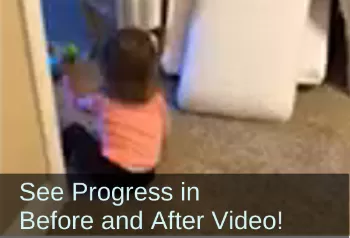Primitive Reflex Integration Case Studies
Delayed Toddler Goes from Only Scooting on Bottom to Walking After 4 Weeks of Innate Sensory-Motor Intervention
PT uses reflex integration to help 20-month old overcome all motor delays
At the time of intervention, this 20-month old with severe developmental delays could not crawl, stand, or walk—her only means of locomotion was bottom scooting. Her physical therapist began providing rhythmic movements and reflex integration, with astounding results: by four weeks she was creeping typically, by two months she was walking through the house. By the time she was 28 months old this toddler was evaluated as being at age level in all domains!
Submitted by Melody Edwards, PT

| Before | After |
|---|---|
| Scooting on bottom was primary means of mobility; unable to commando crawl, creep, or pull to stand or walk | Walking throughout the house with a near-typical gait pattern of a new walker; walking independently on uneven surfaces, going up/down stairs with handrail support |
| Scored -2.13 standard deviations below the mean on the gross motor sub-tests of the Peabody Developmental Motor Scales | A global evaluation at 28 months (8 months after starting the movements) revealed she was functioning at age level in all domains |
At the initial evaluation this child was 20 months of age and used scooting on her bottom as her means of mobility. She kept her chin tucked at all times. She held her eyes locked straight forward or downwards. She was neglecting her upper visual field. When she looked upwards at all, her hips and knees extended and her toes pointed. Obviously, her Tonic Labyrinthine Reflex-extensor was profoundly active. She was unable to commando crawl, creep, pull to stand or walk. Her only word was “dada”. She scored -2.13 standard deviations below the mean on the gross motor sub-tests of the Peabody Developmental Motor Scales.
- I used the Rhythmic Movements [from the Brain and Sensory Foundations course] as my initial treatment strategy.
- I also taught the parents how to work together to do facilitated isometric activities to address the TLR.
- I also used the 5-Step Balance process [from the Brain and Sensory Foundations course] in my initial session so the family could incorporate this process into the child’s daily routine.
5-Step Balance Goal: since the child was so young, the parents set the goal of having her be able to look upwards at least one inch higher without her feet pointing downwards.
Reflexes chosen for the 5-Step Balance: TLR [Tonic Labyrinthine Reflex] was activated, and we worked on integration via a game, which she enjoyed. Over the 23 repetitions she showed much greater range of motion.
Post-balance: the parents were pleased with her progress and expressed that they were confident that they could play this game each night at bedtime right after they did the rhythmic movements.
I choose the rhythmic movements for global facilitation of reflex maturation/integration. I choose the game to focus on a fun way to promote integration of the TLR-extensor in a toddler. I choose the facilitated isometric activities [from the Brain and Sensory Foundations course] to selectively focus on the TLR-extensor since it was negatively impacting her developmental progress.
Client Response - In two weeks child was able to look upwards while prop sitting on the floor without her hips, knees, and toes extending. She also was able to walk up to 10 feet by herself.
- At four weeks she was creeping typically. Head movements were much more separated from her body movements. I added crawling games that involved the child following the light with her eyes as she crawled. Dad would move the light in a multitude of directions, slowly. She was beginning to walk short distances between two people.
- At the two month follow-up visit, the child was walking throughout the house with a near-typical gait pattern of a new walker. I added easel activities.
- At the 6-month follow-up visit, the child was 26 months of age. She was walking independently indoors and outside on uneven surfaces. She was going up/down a flight of stairs with handrail support. She was able to kick a stationary ball with either foot. I added both throwing and kicking activities to her routine.
- Child was discharged from Physical Therapy at 28 months of age due to resolution of concerns about her development.
A global evaluation at 28 months (8 months after starting the movements) revealed she was functioning at age level in all domains.
What did I learn as a result of this case? To address the primitive reflexes rather than putting the child into a crawling or standing position. This allows the child to develop naturally rather than being “taught” each skill.
Did I change my client’s program based on their response? Yes, I introduced other games for the parents to play with their child to promote the integration of the TLR-extensor.
(Edited, emphasis added)
*Disclaimer: The activities in the Brain and Sensory Foundations curriculum make use of the natural processes of neuroplasticity and development that are innately wired in the design of human beings to promote maturity and function. These activities appear to calm, organize, and mature the neuro-sensory-motor systems just as we see in the healthy development of human infants. Individual results may vary, and we do not claim to offer a diagnosis or cure for any specific condition or disorder. The Brain and Sensory Foundations activities appear to improve overall functioning resulting in measurable improvements for a range of conditions as demonstrated in over 1800 case studies from participants.

